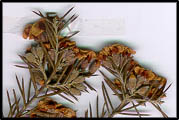South West Slopes Revegetation Guide
Dillwynia juniperina
Prickly Parrot-pea
Select from the following for detailed images.
Species Information
| Synonyms |
|
| Common Names |
Prickly Parrot-pea, Juniper Pea-bush |
| Family |
Fabaceae - Pea family. |
| Name Origin |
Dillwynia - after British botanist Lewis Weston Dillwyn (1778-1855). juniperina - juniper-like, after a prickly European conifer. |
Specimen Data - CSU 2495
| Location |
The Rock Nature Reserve, turn west off Albury/Wagga Rd towards Tootoll. Lat. 36 17'S Long. 147 04'E. |
| Notes |
Zone: Easting: Northing: |
| Collector |
Burrows, Geoff |
Date |
01/08/1987 |
| Determined By |
Hart, David |
Date |
16/03/1987 |
South West Slopes Revegetation Guide Information
| Regional: |
Rare in the region. Noted west of the Hume Highway in the areas: Yambla; The Rock-Henty-Milbrulong; Yerong Creek-Wattle Creek, and Burkes and Graveyard. |
| Australia: |
Qld, NSW, Vic. |
| Habitat: |
Dry sclerophyll forest on various soils. |
| Habit: |
Erect prickly shrub 1-2 m high. Rigid narrow leaves 7-15 mm long. |
| Similar Species: |
Dillwynia sieberi was previously included in Dillwynia juniperina. |
| Site Preference: |
|
| Characteristics: |
|
| Flowering: |
Golden yellow with red. |
| Seed Collection: |
Late Oct to late Feb. Monitor closely as seeds released immediately or within 1-2 days of maturity. Seeds have long storage life. |
| Propagation: |
From scarified seed or cuttings. Soak in near-boiling water for about 30 seconds, before cooling rapidly under flowing cold water. Alternatively soak in cold water for several hours. Dry to prevent rotting before sowing. |
| Regeneration: |
From seed and suckers after fire, forming dense groundcover. Does not establish as readily as most wattles when direct seeded. |
| Timber: |
|
| Shade and Shelter: |
Low cover in windbreaks. |
| Land Protection: |
Legume - improves soil fertility through 'fixing' nitrogen. |
| Wildlife: |
Good habitat. |
| Ornamental: |
Good habitat. |
| Other: |
|
Note: The following information presented is only a guide, as plant characteristics vary depending on provenance (the plant's locality).
| Site/Preferred Habitat : |
well-drained soil |
| Rainfall(mm) : |
400+ |
| Growth Rate : |
moderate |
| Tolerates : |
frost |
| Resents : |
poor drainage |
| Uses & Comments : |
wildlife; fixes nitrogen; ornamental; locally rare. |
Return to Database List
